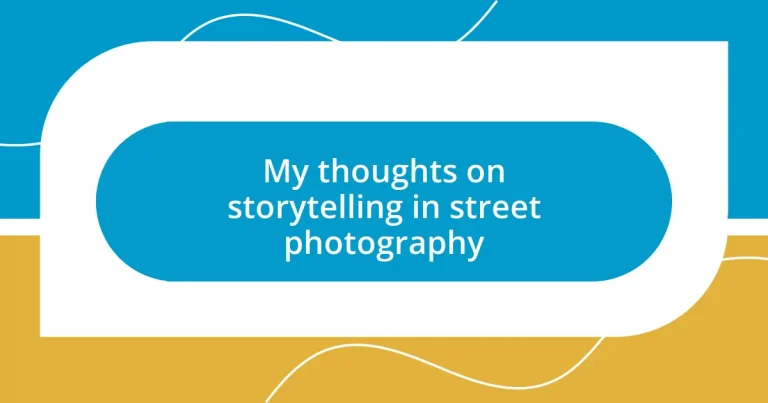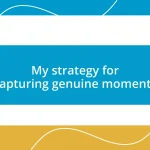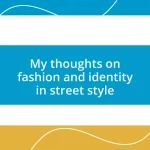Key takeaways:
- Street photography captures spontaneous moments that reveal human connections and evoke emotions.
- Engaging authentically with subjects enriches narratives, transforming simple portraits into powerful stories.
- Composition and lighting are essential tools that influence the emotional depth and storytelling in photographs.
- Every image has the potential to tell a deeper story, influenced by the context and interactions surrounding it.

Understanding street photography’s essence
Street photography captures fleeting moments that tell a deeper story about our everyday lives. I remember one afternoon, as I explored a bustling market, I spotted a vendor sharing a hearty laugh with a customer. That spontaneous interaction reminded me that street photography isn’t just about images; it’s about framing emotions and showing the human connection in a vibrant, chaotic world.
In my experience, the essence of street photography lies in its unpredictability. It’s like chasing a moving target—one moment you see a child splashing in a puddle, the next, an elderly couple sharing a silent conversation on a park bench. How often do we pause to appreciate such forgotten subtleties in our fast-paced lives? Capturing these unguarded moments allows me to infuse my work with authenticity that resonates with viewers.
Every photograph becomes a narrative, breathing life into the ordinary. I’ve found that by stepping back and observing before clicking, I can identify the layer of stories unfolding around me. Isn’t it beautiful to think that each image can evoke a memory or stir an emotion in someone else? In this dance of spontaneity and intention, I believe we uncover the true spirit of street photography.
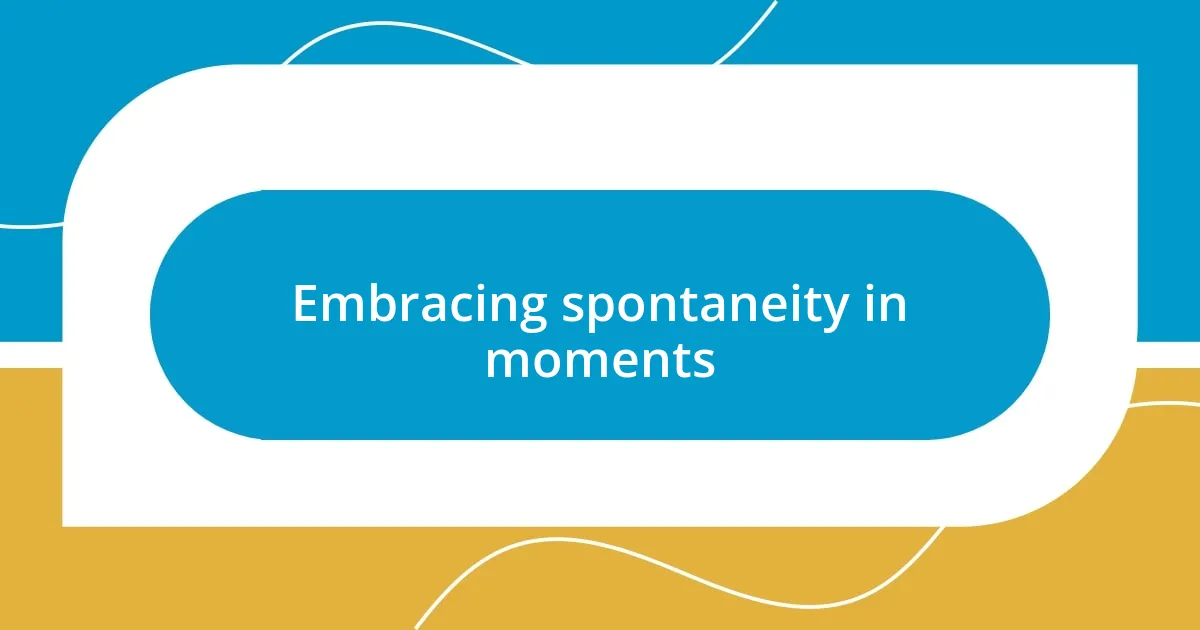
Embracing spontaneity in moments
Embracing spontaneity in street photography is about allowing the unexpected to guide your lens. I recall a moment when I was wandering through a city park, camera in hand, when suddenly a parade of vibrant umbrellas floated past me under a gray sky. It was spontaneous, bright, and it painted a story of joy amidst the gloom. Capturing that scene was a reminder that the most beautiful images often arise when we least expect them.
Sometimes, it’s the fleeting glances and unplanned moments that weave the strongest narratives. I often find myself immersed in the hustle and bustle of urban life, when out of nowhere, a child might giggle while chasing a pigeon. That innocent laughter serves not just as a photograph, but as a reminder of life’s simple joys. I believe embracing these spontaneous occurrences enriches our understanding of the world we inhabit.
When I think about spontaneity, it often leads me to a striking image I captured of two strangers accidentally bumping into each other at a crosswalk. Their surprised expressions turned to laughter in an instant. This simple encounter became a powerful narrative in my portfolio, showing that even in brief moments, genuine connections occur. Isn’t it fascinating how life offers its stories when we keep our eyes wide open?
| Spontaneity in Moments | Planned Photography |
|---|---|
| Captures real emotions | Often staged or controlled |
| Unpredictable, full of surprises | Predictable outcomes |
| Evokes genuine reactions | Can feel contrived |
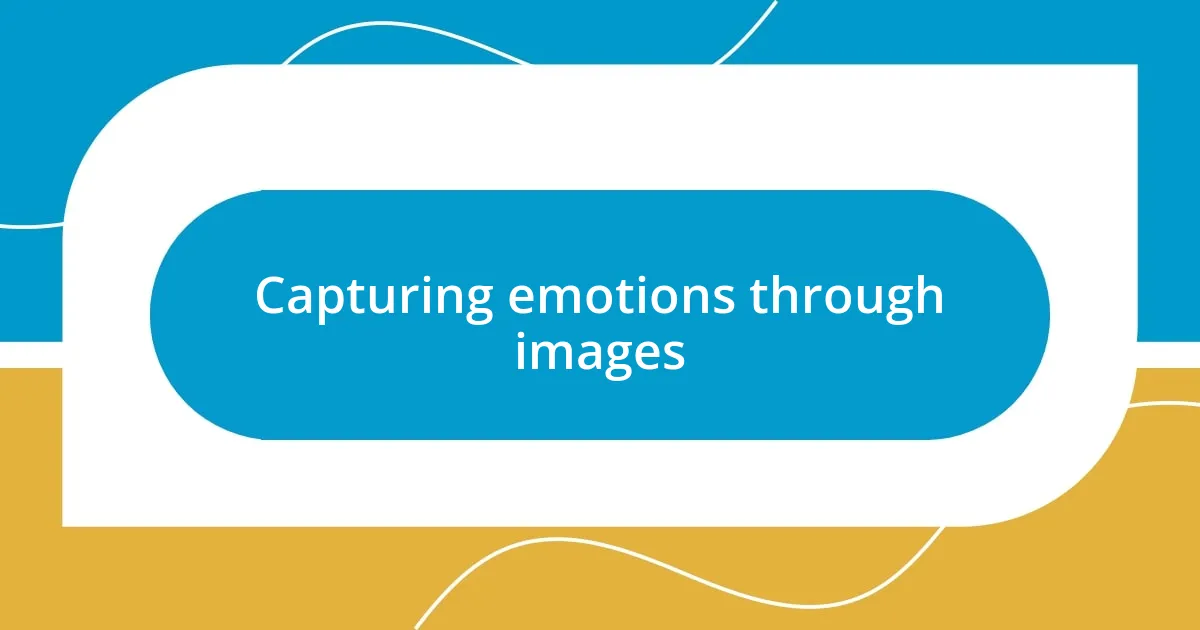
Capturing emotions through images
Capturing emotions through images is like freezing a breathtaking moment in time. I remember shooting a candid scene of a woman on a subway, her eyes filled with a reflective sadness as she stared out the window. It struck me how a simple expression could unveil layers of a person’s story and elicit empathy from the viewer. These are the moments that resonate deeply, reminding us of our shared human experiences and connections.
When it comes to street photography, a few key elements often enhance the emotional impact:
– Facial Expressions: The subtle shifts in a person’s face can convey joy, sorrow, or surprise.
– Body Language: Posture and movement often tell a story of their own, complementing the emotions portrayed by facial expressions.
– Environmental Context: The surrounding setting can amplify the feelings captured in the image, adding depth to the narrative.
– Lighting and Color: The way light hits a subject can evoke specific moods—soft, warm light can inspire comfort, while harsh shadows can create tension or drama.
– Moments of Vulnerability: Capturing someone in a moment of introspection or struggle often leads to images that provoke strong emotional responses in viewers.
Each of these components plays a role in how emotions are communicated through photography. By paying attention to these details, I find my images tell richer, more profound stories that linger in people’s minds long after they’ve seen them.
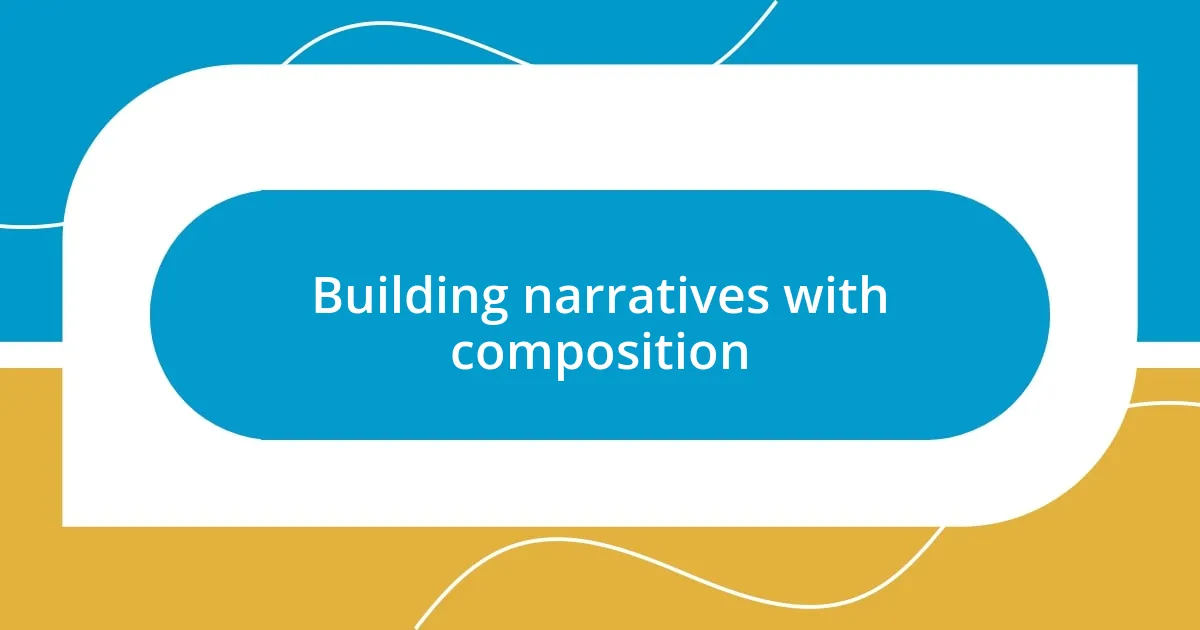
Building narratives with composition
When I approach composition in street photography, I often think about the visual weight each element carries in a frame. For instance, I once positioned myself on a busy corner, capturing the way the shadows of passersby stretched and danced across the pavement. Focusing on the interplay of light and space transformed a simple moment into a statement about urban life, with each shadow contributing to a narrative of movement and anonymity. Isn’t it intriguing how a shift in angle can change the entire story?
The rule of thirds frequently plays a crucial role in how I construct these narratives. By placing a subject off-center, I create tension that invites viewers to explore the surrounding context, drawing them into the scene. I remember a shot of a lone musician playing on the street, with their instrument occupying just a fraction of the frame. This composition forced viewers to notice the empty street around them, evoking feelings of solitude and longing. It’s amazing how a thoughtfully arranged image can provoke such deep emotions, isn’t it?
I also love experimenting with lines and leading perspectives to guide a viewer’s eye through the story I’m telling. Once, while wandering through a market, I framed a vendor with rows of colorful produce leading toward them, creating a sense of abundance and inviting the audience to feel the vibrancy of the atmosphere. This mindful approach to composition does more than just portray a moment; it invites viewers to become part of that narrative journey. Have you ever found yourself lost in the lines of a photograph, feeling the story unfold right before your eyes?
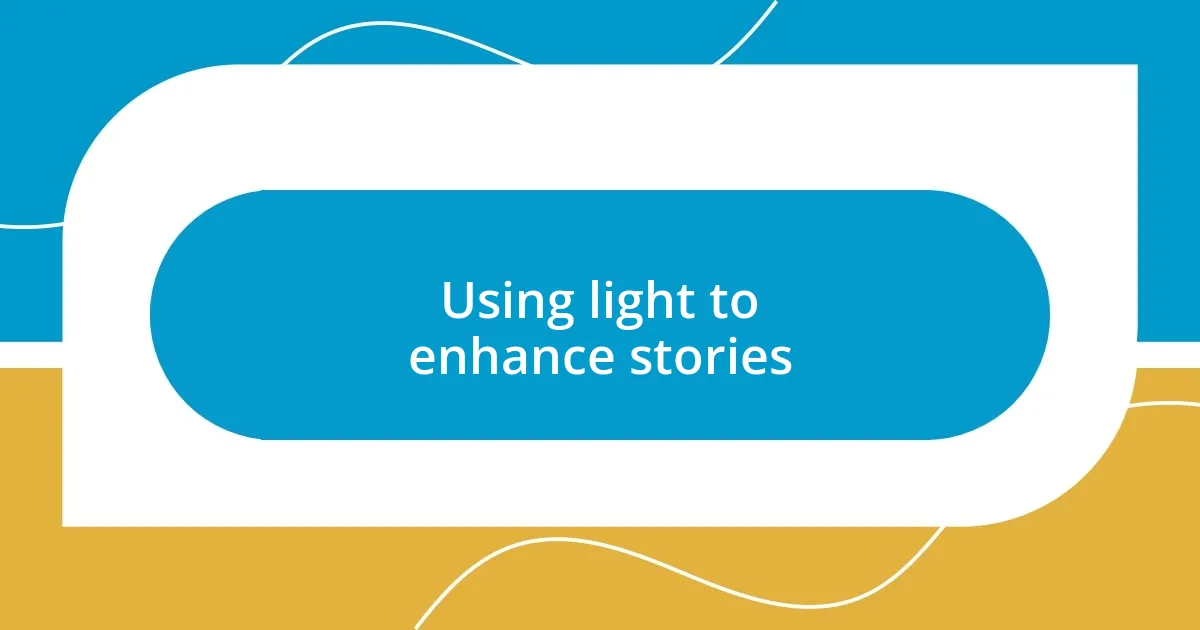
Using light to enhance stories
I’ve always found that light can completely transform a scene. One evening, I was wandering through a bustling street market just as the sun began to set. The golden hour cast a warm glow on everything, creating a dreamy atmosphere that breathed life into the ordinary. Capturing that soft light turned mundane moments—like a vendor chatting with a customer—into something magical. Isn’t it fascinating how light can infuse a simple exchange with such depth and emotion?
In another instance, I focused on a group of children playing in a park. The late afternoon sun created long shadows that elongated their laughter and movement, adding a sense of nostalgia to the image. I remember feeling a wave of joy wash over me as I snapped that photograph, realizing how the interplay of light and shadow not only illustrated their carefree memories but also hinted at the fleeting nature of childhood. Don’t you agree that light can make us reflect on the passage of time?
Additionally, experimenting with different lighting conditions can yield unexpected results. During a rainy day, I captured a street scene under soft, diffused light. The atmosphere was somber, yet it revealed a quiet beauty in the reflections on the wet pavement. I felt there was a poignant story waiting to be told—a moment of solitude amidst the hustle of life. It’s moments like these that remind me of the power of light to shape narratives, isn’t it?
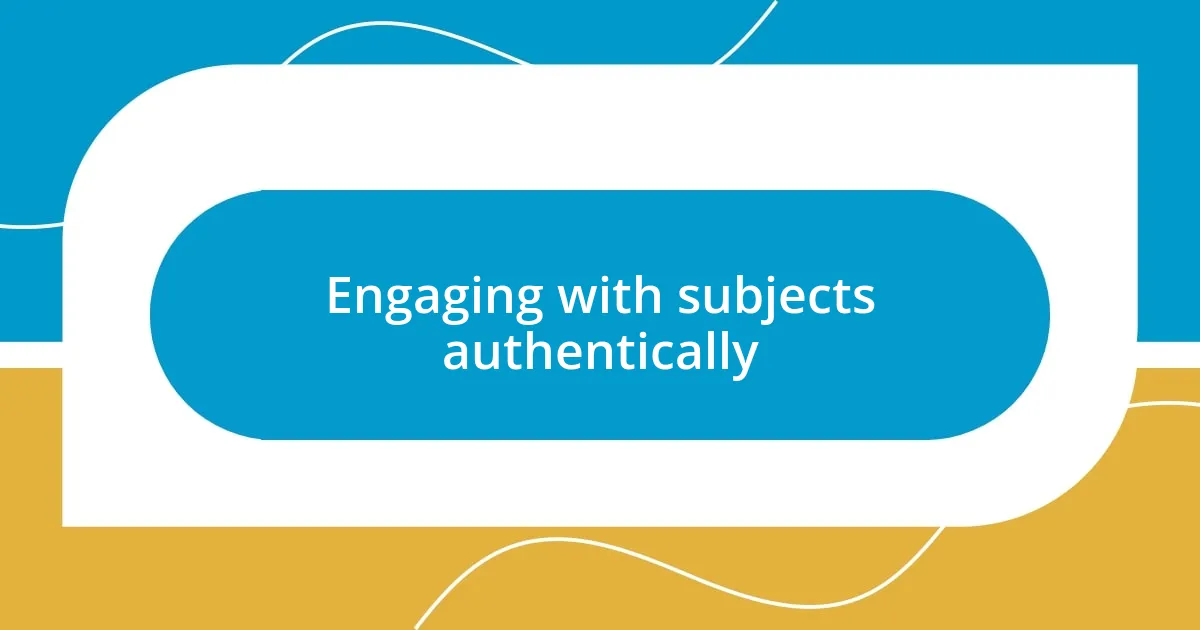
Engaging with subjects authentically
Engagement with subjects requires a genuine curiosity about their stories. I remember standing near an elderly man sitting on a park bench, completely lost in thought. Instead of approaching him directly, I took a moment to observe his expressions and the world around him, feeling that his solitude contained a lifetime of experiences waiting to be shared. Isn’t it incredible how just pausing and connecting can transform a standard portrait into a heartfelt narrative?
When I finally approached him, it was like opening a door to a rich, emotional archive of memories. As we talked, I discovered he had spent decades crafting intricate wood sculptures. His passion was palpable, and I could see the spark in his eyes as he recounted tales of his art. Capturing that moment, the interplay of his animated expressions against the backdrop of the park, turned a simple image into a powerful story about resilience and creativity. Have you ever found that heartfelt conversations can completely change how you perceive your subject?
I also believe that respecting personal boundaries is crucial for authentic engagement. Once, while photographing a group of street performers, I noticed one performer seemed shy and hesitant. Instead of snapping away, I took the time to ask for permission and explain my intentions. That small act made a difference; as soon as she saw my respectful approach, her posture changed, and she began to truly perform for the camera. I couldn’t help but feel a sense of connection and appreciation for her trust. Isn’t it interesting how authenticity in our interactions can reflect in the authenticity of our images?
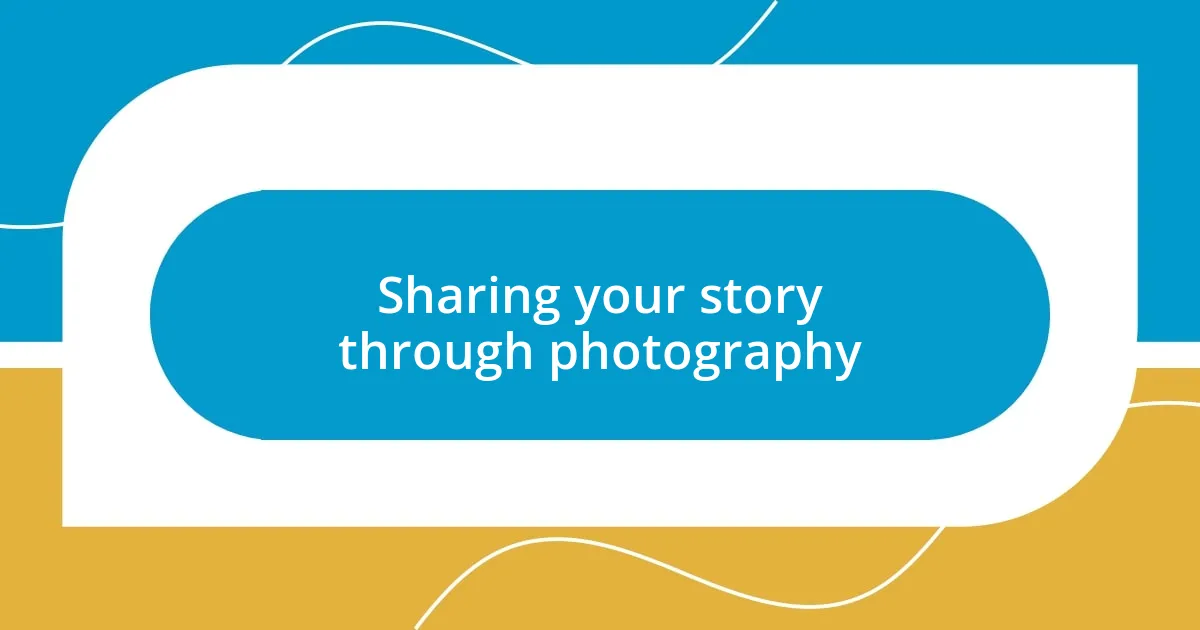
Sharing your story through photography
Every photograph tells a story, but it’s the personal touch that makes it resonate. I recall a day spent at a bustling street fair, where a woman selling handmade jewelry captivated me with her animated storytelling. As I captured her weaving tales of inspiration behind each piece, I realized that each image wasn’t just a moment in time; it was a narrative about her passion and creativity. How often do we find ourselves lost in the stories behind the images we create, don’t you think?
In another instance, I came across a mural that had become a canvas for the community’s struggles and triumphs. The vibrant colors and striking imagery spoke volumes, but what truly struck me were the people gathered around it, sharing their thoughts, laughter, and experiences. I wanted to capture that synergy. By focusing on the conversations happening before the mural, I found that my photographs became a window into the collective heart of that neighborhood rather than mere snapshots of its art. Isn’t it amazing how the context of a photograph can turn it into a profound narrative?
Sharing your story through photography often involves finding those raw and intimate moments. One evening, I stumbled upon a couple dancing joyfully in the rain, laughing and embracing the moment. Capturing that unfiltered bliss reminded me that love exists in the most unexpected and fleeting times. I felt as if I had captured not just an image but the essence of their relationship—vulnerable and beautiful. What stories are waiting to be seized just beyond our lens?












